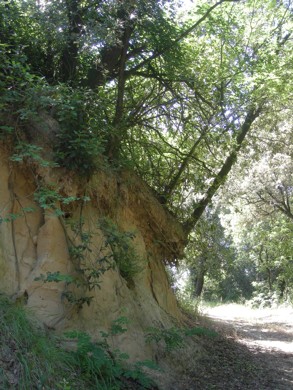|
ILCI
di Todi (Pg-Italy)
Myth
and Legend.
This territory was
inhabited even in prehistoric times, as evidenced by the findings
that the farmers made by plowing the fields and reviving what they
called "saette", imagining them as residues of lightning, but which
were instead, "amigdale" **** of chipped stones used in the stone
age.
The Abbot of Ripabianca ANDREA GIOVANNELLI *, in 1700, realized the
importance of these finds and, since there was not yet a museum in
Todi, he gave them to Giovan Battista Passeri di Pesaro to be kept
in that museum where they are still located.
From the Roman era the town maintains the essential structure with
the CARDO and the DECUMANO **, even if the negligence of time and
men has dispersed the significant testimonies of which remains only
legend as the temple of the DEA BONA and in particular of a temple
dedicated to FAUNO, God of the woods.
In this regard, writes G.B. Alvi in his Dictionary, "It was
conjectured that this place was superstitious, since, being under
the tree, a tree consecrated to the Fauns, there was a temple in
honor of Faunus, where wishes and wishes were made".
*** Magic place:
(See the "Macchia di Boccone" where, it was imagined, the witches
would meet and where the "sabba" took place).
|

|
|

|
* Andrea
Giovannelli
February 13, 1696
was born in Ripabianca from an illustrious family Andrea Giovannelli,
an important figure of scholar and archaeologist.
He was, first, a master of human letters at Ripabianca and, later,
at Todi and Rome as librarian of Filippo Antonio Gualterio
(1660-1728), in 1708 archbishop of Todi. In Todi between 1716 and
1717 he met and became a good friend of the Pesaro-born scholar
Gianbattista Passeri (1694-1780).
Until 1748 he collected, in a manuscript, news on archaeological
excavations, studies on antiquities in general and fortuitous finds
occurred in the Todino territory.
Divided into seven volumes by Gianbattista Passeri who has added an
introduction to it, the Diario Todino, overo Report of the discovery
of several antiquities followed in the city of Todi and its
territory, and in nearby and neighboring places of Andrea
Giovannelli, is preserved in the Oliveriana Library of Pesaro.
|
** ** Cardo and decumano
constituted the two fundamental lines of centuriation, intersecting
at right angles. The decumanus is originally drawn from east to
west, generally in the axis of the length of the portion of
territory established; the thistle crosses it from south to north.
The secondary lines (limites), parallel to thistle and decumanus,
form the centuries. Cardo and decumano are also the main streets of
the Roman cities and encampments.
**** Amigdale: In archeology it is referred to as amygdala or
bifacciale, a stone shaped like an almond, chipped and worked to
make it sharp, which is found among the artifacts of human origin in
protohistoric housing sites. |

|
|
___________________________________ |
|
Images by Andrea Ceccarini |
|